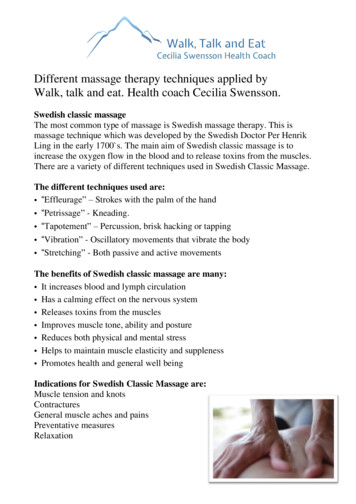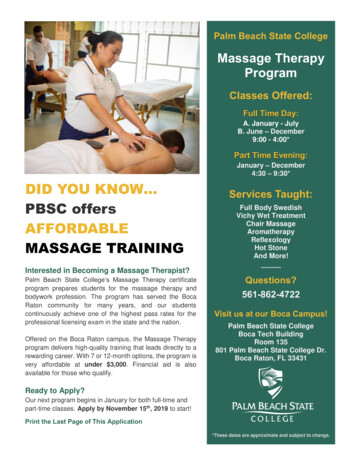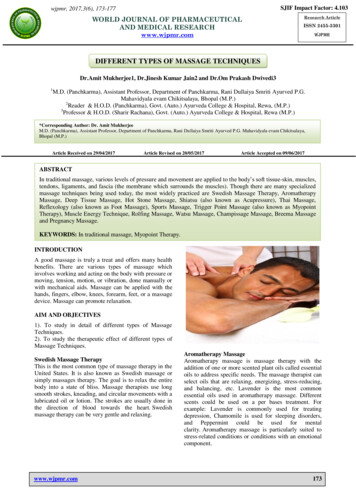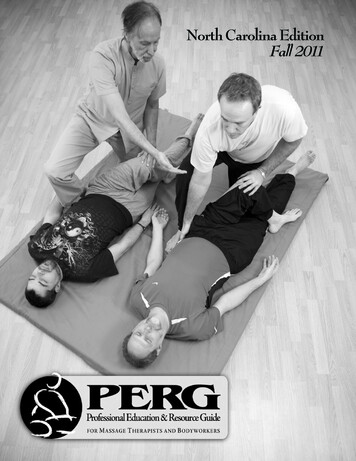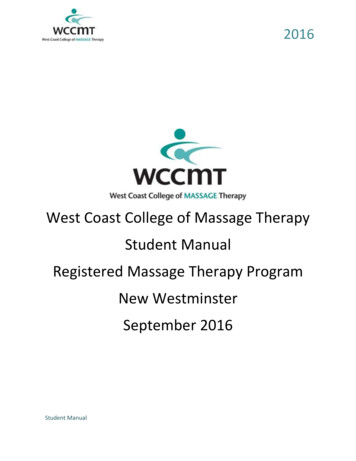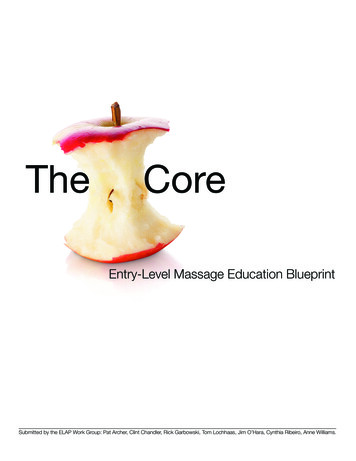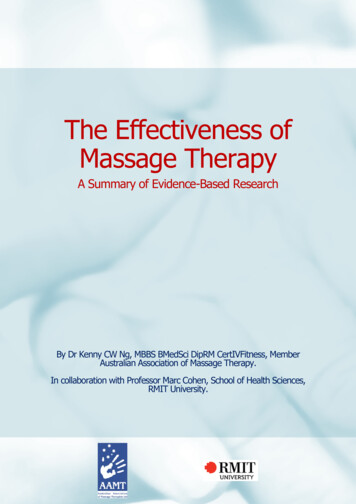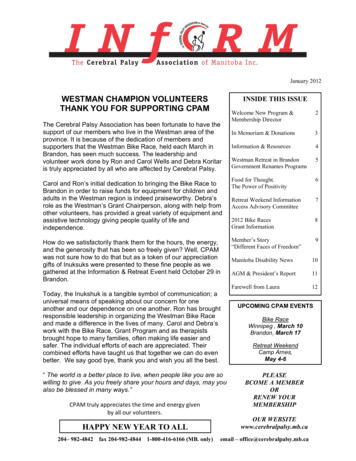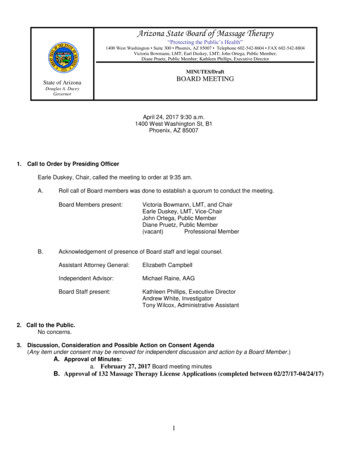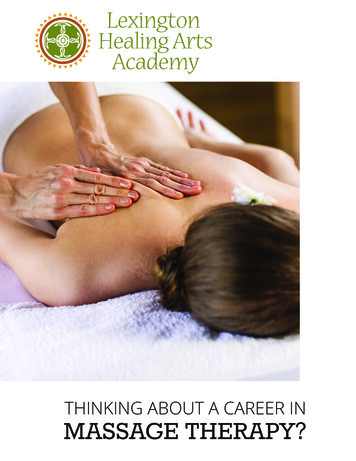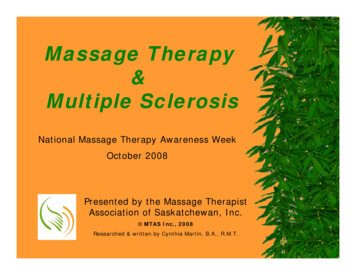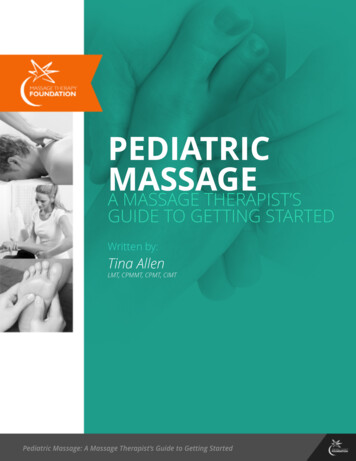
Transcription
!PEDIATRICMASSAGEA MASSAGE THERAPIST’SGUIDE TO GETTING STARTEDWritten by:Tina AllenLMT, CPMMT, CPMT, CIMTPediatric Massage: A Massage Therapist’s Guide to Getting Started
Why pediatric massage?Babies and children simply love to be touched. In fact, they thrive on it and it is acrucial part of their development. Children need physical contact for healthy growthand development. Nurturing touch promotes physiological, neurological and psychological development and function.Healthy children receive the benefits of touch from many sources, but just as withadults, the symptoms of physical and emotional stress can often be alleviated bymassage therapy from a trained professional. Some of these can include‣strenuous athletics or exercise‣physical pain from injury or medical treatment‣family difficulties, including death, divorce, or moving‣difficulties in school, either academic or social‣natural disasters or other traumatizing eventsSadly, not all children receive the basic, necessary touch in their everyday lives. Thiscan sometimes happen when children‣live in an institutional environment (hospital, nursing home, orphanage)‣have a medical condition that makes people afraid to touch them (legitimate‣have a condition that makes untrained touch dangerous‣have been neglected or abused at home‣have a condition that makes them averse to touchor imagined)Pediatric Massage: A Massage Therapist’s Guide to Getting Started
As you can see, a wide variety of children can benefit from massage, from all-starathletes to premature infants to teen runaways. Pain, anxiety, loneliness, and fearare not unique to adults, so it only makes sense that those who serve children, including families, medical facilities, and nonprofit organizations, are looking to pediatric massage as a source of relief.Unfortunately, not everyone currently has access to the services of those trained inpediatric massage. A pediatric client’s vulnerability both physically and emotionallymakes training vital for those who plan to work in this specialty. It is also importantto communicate with the child's attending physician in order to ensure her safety.Neither standard medical training nor basic massage therapy education providesthis kind of specific background, so the need for more trained practitioners is verygreat. Numerous studies demonstrate the effectiveness of pediatric massage therapy when safely provided by trained healthcare practitioners. The possibilities in thefield continue to grow!!Pediatric Massage: A Massage Therapist’s Guide to Getting Started
How is pediatric massage different from massagefor adults?Children are more than just small adults. Physically, mentally, emotionally, (and yes,legally), they have unique needs, wants and limitations. In addition, there is farmore variation in childhood than in adulthood. Imagine if we went through as manyphysical changes between the ages of 30 and 40 as we did between two and twelve!Having a basic understanding of child development is important, but even more essential is the willingness and flexibility to meet each child at his or her own level ofdevelopment, wherever that might be.Several facets of this flexibility that must be apparent when providing massagetherapy for children can be expressed as the Five Ps: permission, pace, pressure,positioning, and parents.PERMISSIONAlways, always, always obtain permission from the child before engaging in anyform of touch therapy. Children, especially very young children, do not always understand that they have a right to disagree with an adult who has come to providetreatment. This is especially true for hospitalized children, who may undergo uncomfortable or painful treatments that cannot be refused. Empowering a child tohave a voice in her medical care can not only reduce her stress, but can also improve her entire experience as a patient who takes an active role in her own health.Pediatric Massage: A Massage Therapist’s Guide to Getting Started
What do you do when a child is unable to verbalize her consent? If a child is able to understand you, asking yes or no questions may beeffective if the child can respond with gesturessuch as nodding. Parents and caregivers whoare familiar with the child’s communication canoften be a great help in determining what she istrying to say. When working with infants and children who may have difficulty understanding your questions or are unable to respond, you may have to rely on bodylanguage. Pulling away, shallower breathing, or sudden tightening of the musclescan all indicate pain, fear, or unwillingness to continue and should be taken just asseriously as if the child had told you outright, “I don’t like that.”Understand that, while some children may warm up to you in time, there are otherswho simply will not want to work with you, ever. Accept this graciously. It is neithera failure on your part, nor on that of the child.When dealing with a child who is under a doctor’s care, it is also important to receive approval from the child’s attending physician in order to ensure her safety.The contraindications for massage therapy may not always be the same as thosefor adults, so even a practitioner with experience working with medical patientsshould exercise caution. It is best to receive permission prior to each session, incase any medical changes have occurred.!Pediatric Massage: A Massage Therapist’s Guide to Getting Started
PACEDo you remember being a young child, when half an hour was an agonizing wait,and an hour was the end of the world? While many adults find a massage lasting anhour or longer to be heavenly, it can be too much for even a patient child. Healthychildren can find it difficult to be still for such a long period, while children withsome medical conditions may find longer massages tax their already limited energy.When working with younger children, massages that last 15-20 minutes may be thebest fit for their attention spans. Sometimes, shorter massages may be provided tothe same child multiple times a day, resulting in a similar amount of total treatmenttime provided to an adult or teen who receives a longer, once-daily massage.PRESSUREThere is no general rule for the amount of pressure to use with pediatric clients.One might find a firm touch comforting, while for another it might be painful. Thesame light pressure that soothes one child to sleep could be agonizing to a veryticklish child. As always, it’s important to meet each client, case by case, day by day,where she stands.Allowing children to have control over the amount of pressure is very important. Beprepared for children to test out this control, asking for more, then less pressure inorder to gauge whether you will actually respond. Building this trust with the childis just as important as what you might consider the treatment itself, and you mayspend entire sessions just working on this trust. Only after you have developedtrust and rapport between you will the child be able to relax and enjoy the manybenefits of your massage.Pediatric Massage: A Massage Therapist’s Guide to Getting Started
POSITIONINGWhat may be comfortable for you might not be comfortable--or even possible--witha child. This is especially true of children who are confined to a bed, are attached toIVs or other medical equipment, or who experience chronic pain.It’s good to practice different positions, including supported side-lying,supine, and semi-reclined. These positions allow you to keep eye contactand notice any facial movements thatcould alert you of any discomfort. Ofcourse, you’re not limited to thesepositions. Be creative in making yourclient comfortable! Sitting, standing, or lying in another position might be most effective. Very young children might prefer to be held by a parent, especially if theyare shy and have never received a massage before. In general, most pediatric massage is performed fully clothed, so draping is not an issue when considering positioning. This allows you to focus exclusively on the comfort and safety of your client,rather than juggling issues of modesty as well.PARENTSCaring for a child, whether she’s a wannabe stunt-double with a strained muscle ora toddler with leukemia, can be a nerve-wracking process. Parents are under constant pressure to make the right decisions to ensure that their children are healthy,happy, and prepared for their next stage of life. Introducing massage therapy intotheir child’s life, while increasingly common, is still an unusual choice, which canPediatric Massage: A Massage Therapist’s Guide to Getting Started
lead to additional tension. Because of all this, it’s doubly important to work with theparents (or guardians) and not only the child.At the beginning of the session, remind the parent that your focus will be on thechild, but that you will be happy to discuss the session or answer any questions atthe end of the treatment. Show parents some simple techniques to help them relax,such as taking some deep breaths or rolling their shoulders. The massage session isa great time for parents to practice a little self-care while you tend to the needs oftheir child. Explain the importance of relaxing prior to touching their child. Thenshow them some simple techniques they can use without harming their child.In many cases, you will not be able to provide all the massage that the child needsor could benefit from. In this situation, teaching the parents a few massage techniques to use with their children will not only ensure that the child receives additional massage, but will also encourage healthy, positive interaction between parentand child. In addition, many parents feel helpless when faced with a child’s injury,illness, or anxiety. Empowering parents to be an active part of their child’s healingprocess can help alleviate their own anxiety, which will lead to a happier, healthierenvironment for your young client.When providing pediatric massage it’s vital to have a thorough understanding ofmandatory reporting laws in your state. Massage practitioners are in a unique position to see indicators of both mental and physical abuse, and confidentiality rulessurrounding minors are complex. Consult the regulating body in your state to learnand understand the laws.!Pediatric Massage: A Massage Therapist’s Guide to Getting Started
Settings for Pediatric MassageHOSPITALSThe type of work you do with pediatric patientsin a hospital will depend on the scope of yourjob description: some massage therapists inhospitals are strictly for emotional support,while others are focused on specific pain reliefor rehabilitation goals. Although hospitalizationof an adult is stressful, hospitalization of a childcan be even more so, and to family and friends as well as the patient. Pediatricmassage in a hospital setting requires extra communication to alleviate everyone’sworries, but also provides many opportunities for education and increasing awareness.NURSING HOMESWhen it comes to adults, nursing homes are most likely to be used for two reasons:short-term, to recover from a medical emergency or injury, or long-term when theycan no longer function independently and cannot be adequately cared-for at home.Children typically go home for recovery, and are not expected to function independently to begin with. So children who live in nursing homes, either special pediatricor general, are often those with the most severe medical issues. For this reason, it’sespecially important to communicate frequently with the Director of Nursing in order to provide the safest, most appropriate care.Pediatric Massage: A Massage Therapist’s Guide to Getting Started
OUTPATIENT CLINICSUnlike an adult, a child will not drive herself to her therapy appointment. Most often, a parent or other adult will be present during the session, especially when anew treatment is being added, such as massage. Visits to outpatient clinics have aspecific purpose, and goals are set by the therapist. In this case, you may be dealingwith three different people with different goals in mind: the physical therapist (forexample), who wants the child to be able to walk three laps around the room unassisted, the child, who just wants to feel better, and the parent, who wants both ofthose things and also for life to be as normal as possible. It can be tricky to try andaccommodate these related-but-different goals while staying within your scope ofpractice, but it can be a very rewarding experience when you strike the right balance.HOSPICEWorking with dying children can be emotionally difficult even for the most experienced hospice workers. If you decide to take on this kind of work, make sure youhave your own emotional support system firmly in place. Also, consider making thehospice setting (which may be an actual facility or take the form of home visits),only part of what you do. Prenatal massage or short-term rehabilitation both offeran atmosphere of progress and hope to balance out the inherently sad nature ofworking with children for whom there will be no recovery.!Pediatric Massage: A Massage Therapist’s Guide to Getting Started
PRIVATE PRACTICESince the majority of massage therapists work in some form of private practice, itmakes sense that this would be a common setting for all kinds of massage, including pediatric. With some adjustments, most private practices can be excellent settings for pediatric massage. Can the child get on and off the table? Is there seatingin your treatment room for a parent to be present if she wishes? Do you have information printed about your policies specifically about children? Do you have anykid-friendly reading materials in your waiting room? Each child who visits your practice is one more child who has grown up integrating massage into her everyday life.And that’s good for everyone!HOME VISITFor some children, especially those who struggle with anxiety, the most therapeuticenvironment is the safety of their own homes. Massage therapists who regularlyprovide in-home massage will find this to be a natural outgrowth of their business,while those who don’t may be nervous about packing up their entire kit to visit achild who may only want 15 minutes of massage or none at all! However, if youview education and building rapport to be just as much a part of the job as thehands-on time (and you keep your prices fair accordingly), home visits can be agreat way to reach children that you wouldn’t have the opportunity to work with inany other setting.!Pediatric Massage: A Massage Therapist’s Guide to Getting Started
Education and TrainingAs in all specialties of massage, advanced training matters. You should choose yourcontinuing education carefully and consider the following factors.LOCATIONAre you near a massage school that hosts continuing education classes, or are youout in the middle of nowhere? Choosing an ideal location for your CE class alsomeans factoring in your budget. If you’re near a school, congratulations, you’ve gotit easy! Pack a lunch, gas up the car, and you’re all set. If you’ve got to travel just tofind a good cup of chai, chances are you’ll need to pack a bag to get to a good class,too. Keep in mind that many instructors will travel to you if you can gather enoughcolleagues to take the class! Don’t be shy about contacting an educator to ask abouthosting a class.Pediatric Massage: A Massage Therapist’s Guide to Getting Started
INSTRUCTORIt can be frustrating to get all settled into your seat, have the class begin, and instantly realize that you don’t ‘click’ with the instructor. Maybe it’s their speakingstyle, their sense of humor, or just the pace of the class. You can avoid this mishapby doing your homework. Does the instructor have any videos or clips online of aclass? Check them out! Or if the instructor has participated in webinars, you canusually purchase a recording for a reasonable price. That’s a smart expenditure(and may get you CE hours!) if it ensures you choose the right class for you. If you’reactive on social media, reach out to your colleagues for feedback, a friend may havetaken a class and have some great pointers for you.QUALITY OF MATERIALMany education companies are individuals, so determining the quality of the education is often just a continuation of researching the instructor. Some factors toconsider are:‣how long the company/instructor has been practicing and teaching this spe-‣if they are published in magazines and journals you read and respect‣if the instructor is connected with other educators you like and respect‣if the instructor uses research to inform and teach their specialtycialtyIf you investigate the program and instructor, but still aren’t sure, just email or callthe instructor! Ask your questions directly and get a sense of the program beforeyou commit.Pediatric Massage: A Massage Therapist’s Guide to Getting Started
Pediatric Massage for Specific ConditionsAUTISMFor children with autism, research has been published indicating that massage mayprovide relaxation, stress reduction and calm muscle spasms. Research has alsodemonstrated that this type of intervention may promote more on-task and socialrelatedness behavior during play, children with autism spectrum disorders showless erratic behavior, and are more attentive after receiving massage therapy. Thissafe, nurturing touch, along with regular sensory integration, is beneficial in reducing inattentiveness, touch aversion and withdrawal. Over time, touch therapy alsohelps the child to become more accustomed to tactile stimulation and aides in bodyawareness. Often by incorporating massage therapy into daily routines, childrenwith autism experience fewer sleeping problems.CANCERComplementary therapies are being increasingly integrated into mainstream cancerprograms and centers. Although most studies have reported the effects of massagein adult patients, pediatric cancer patients also experience reduced pain after massage therapy. Massage is one of the most commonly used pain managementstrategies for pediatric patients newly diagnosed with leukemia. For oncology patients, studies also indicate that many complementary therapies control treatmentrelated physical and emotional symptoms including pain, fatigue, nausea, xerostomia (dry mouth), anxiety, and depression.A recent study took a close look at the effect of massage on cancer patients. In astudy of 380 adults with advanced-stage cancer and at least moderate pain, the re-Pediatric Massage: A Massage Therapist’s Guide to Getting Started
searchers found that those who received massage therapy had greater improvement in pain and mood than patients who were touched in a manner similar tomassage but without the precise motion and the specific pressure a trained massage therapist uses.For cancer patients, especially pediatric cancer patients, even just a little relief canmean a lot. In general, about a third of all cancer patients experience significantpain. According to the National Cancer Institute, 15% to 25% of cancer patients become clinically depressed at some point during their illness. And, of course, thestress of hospitalization, isolation, and treatment for this very serious illness canmake all these symptoms worse.During massage, levels of feel-good neurotransmitters such as serotonin anddopamine spike, oxytocin (the nurturing, cuddle hormone) is increased, while measures of the stress hormone cortisol drop. When using massage therapy for children with cancer, your work does not need to be aggressive to achieve its maximum potential. Trained, gentle touch can be just the treatment these children need.CEREBRAL PALSYCerebral palsy (CP) is a term that refers to many possible injuries to the brain usually occurring during fetal development; before, during, or shortly after birth; duringinfancy; or in early childhood. CP is not a disease: it’s neither progressive nor communicable. The United Cerebral Palsy Research and Educational Foundation estimates between 1 ½ - 2 million children and adults have cerebral palsy in the UnitedStates. 10,000 babies and infants are diagnosed with cerebral palsy annually, andPediatric Massage: A Massage Therapist’s Guide to Getting Started
1,200-1,500 preschool-age children are also recognized to have cerebral palsy eachyear.There are several types of cerebral palsy which involve damage to different parts ofthe brain, and affect body movement, posture and muscle coordination. Thesetypes are categorized into four types: spastic, athetoid, ataxic, and mixed.Without question, massage therapy can have a valuable role in improving the quality of life of a child with cerebral palsy. Research performed by the Touch ResearchInstitute has indicated children affected by cerebral palsy receiving massage therapy showed fewer physical symptoms including reduced spasticity, less rigid muscletone overall and in the arms, and improved fine and gross motor functioning. Inaddition, the massage group experienced improved cognition, social, and dressingscores on the Developmental Profile and showed more positive facial expressionsand less limb activity during face-to-face play interactions. Massage may also behelpful in decreasing tone in spastic muscles, relieving tension and spasms, andimproving digestion.!Pediatric Massage: A Massage Therapist’s Guide to Getting Started
UNDERSERVED POPULATIONSChildren in orphanages around the world mayhave food, clothing and shelter, but often theylack an essential ingredient for basic health andhappiness—touch. Without it, children often feeldiscarded, forgotten, and even untouchable, especially when their circumstances are complicatedby being sick or having a disability.Orphans have many physical needs, and becausethese needs are the most immediate, they are themost urgent. However, children have significantemotional needs as well. Experience has shownthat orphanages find it a challenge to meet the emotional and developmentalneeds of children, including personalized care and attention. Massage therapy canprovide not only physical stimulation to underused bodies, but also gentle touch,social interaction, and the knowledge that someone cares, fostering the hope andconfidence needed to take their place in the world as part of society.HEALTHY CHILDRENMassage isn’t just for big, bad medical conditions with intimidating names. The littletroubles of childhood respond just as well. Constipation. Tension headaches. Growing pains. Massage therapy can improve the quality of sleep, enhance body image,decrease anxiety, and reduce aggressive behavior. These aren’t earth-shaking issues, but what parent wouldn’t appreciate the person who could help a hyperactivesix-year-old sit through story time, or 12-year-old feel like her changing body wasPediatric Massage: A Massage Therapist’s Guide to Getting Started
actually pretty okay? It may not seem like much, but to the loving family of a child, itcan mean the world. Don’t ignore healthy kids when looking for pediatric massageclients!Pediatric Massage: A Massage Therapist’s Guide to Getting Started
Community service ideas within pediatric massageFOCUS ON CHILDREN WITH A SPECIFIC MEDICAL CONDITIONIn 2009, Congresso de Latinos Unidos received a grant from the MTF to providechair massage for individuals living with HIV and AIDS. In the US, HIV children nowreceive treatment and are living longer, but often still deal with stigma. Abroad, particularly in Asia and Africa, the number of children with HIV and AIDS continues togrow. Research has shown that massage can help children with conditions rangingfrom asthma to cystic fibrosis and a host of conditions in between. Who knows?Perhaps your program will be the first to show promising results in using massagetherapy as a part of a certain condition’s treatment in children.FOCUS ON CHILDREN BELONGING TO A SPECIFIC POPULATION IN NEEDIn 2008, Family of Woodstock joined forces with Healthcare isa Human Right to provide massage therapy, bodywork, andwellness education to homeless individuals in their region.Given that there are 1.6 million homeless children in the US,this is a group that is not only large, but very much in need ofphysical and emotional support. Other groups to considerare children who have experienced some form of traumasuch as a natural disaster, child refugees, or children withfamily members who are hospitalized, in prison, or being treated for substanceabuse. In 2012, Family of Woodstock and Healthcare is a Human Right received another grant, focusing on individuals affected by Hurricane Irene, so this method isclearly succeeding!Pediatric Massage: A Massage Therapist’s Guide to Getting Started
FOCUS ON CHILDREN IN A SPECIFIC SETTINGThe 2012 Massage Therapy Foundation grantee Reid Massage Therapy Senior Outreach program focuses on providing massage to individuals who frequent several community centers in rural Indiana and Ohio. Working with a specific setting, such as a hospital, school, or resource centerthat is already serving children provides not only a simpleway to reach those in need, but also the sorts of strongpartnerships that make a program sustainable in the longterm.FOCUS ON TRAINING OTHERSIn 2008, a Community Service grant was made in order to support training familiesand caregivers of the elderly in massage techniques to alleviate common issuessuch as muscle pain, insomnia, abdominal discomfort, depression, and anxiety. Byfocusing on or including training in your community service, you can ensure thatyour program will be able to reach more people over a longer period of time. Caregivers of children include parents, grandparents, foster families, nurses, and professional childcare providers. Who do you know that could improve the lives of thechildren around them with some basic training in massage?THE OPPORTUNITIES IN PEDIATRIC MASSAGE ARE LIMITLESSEnjoy exploring your interest and education in pediatric massage!!Pediatric Massage: A Massage Therapist’s Guide to Getting Started
ReferencesAli S, Drendel AL, Kircher J, Beno S., Pain management of musculoskeletal injuries in children: currentstate and future directions. Pediatr Emerg Care. 2010 Jul;26 (7):518-24; quiz 525-8. Review.Beider, S., Moyer, C., Randomized Controlled Trials of Pediatric Massage: A Review, evidence-basedcomplementary and alternative medicine, vol. 4, no. 1, pp. 23-34, 2007Escalona, A., Field, T., Singer-Strunk R., Cullen, C., & Hartshorn, K. (2001). Brief report: Improvementsin the behavior of children with autism following massage therapy. Journal of Autism and Developmental Disorders, 31, 513-516Evans S, Tsao JC, Zeltzer LK., Complementary and alternative medicine for acute procedural pain inchildren. Altern Ther Health Med. 2008 Sep-Oct;14(5):52-6. Review.Field, T., Cullen, C., Diego, M., Hernandez-Reif, M., Sprinz, P., Beebe, K., Kissel, B. & Bango-Sanchez, V.(2001). Leukemia immune changes following massage therapy. Journal of Bodywork and MovementTherapies, 3, 1-5.Field, T., Lasko, D., Mundy, P. & Henteleff, T., Kabot, S., Talpins, S. & Dowling, M. (1997). Brief report:Autistic children's attentiveness and responsivity improved after touch therapy. Journal of Autism &Developmental Disorders, 27(3), 333-338.Field, T., Lasko, D., Mundy, P., Henteleff, T., Talpins, S., & Dowling, M. (1986). Autistic children's attentiveness and responsitivity improved after touch therapy. Journal of Autism and Developmental Disorders, 27, 329-334.Field, T., Morrow, C., Valdeon, C., Larson, S., Kuhn, C., & Schanberg, S.(1992). Massage reduces depression and anxiety in child and adolescent psychiatric patients. Journal of the American Academyof Child & Adolescent Psychiatry, 31, 125-131.Pediatric Massage: A Massage Therapist’s Guide to Getting Started
Field, T., Morrow, C., Valdeon, C., Larson, S., Kuhn, C., & Schanberg, S. (1992). Massage therapy reduces anxiety in child and adolescent psychiatric patients. Journal of the American Academy of Childand Adolescent Psychiatry, 31, 125-30.Field, T., Quintino, O, Hernandez-Reif, M, Koslovsky, G., (1998). Adolescents with attention deficit hyperactivity disorder benefit from massage therapy. Adolescence, 33: 103-8.Field, T., Seligman, S., Scafidi, F., & Schanberg, S. (1996). Alleviating postraumatic stress in childrenfollowing Hurricane Andrew. Journal of Applied Developmental Psychology, 17, 37-50.Haun JN, Graham-Pole J, Shortley B, Children with cancer and blood diseases experience positivephysical and psychological effects from massage therapy, Int J Ther Massage Bodywork. 2009 Jun29;2(2):7-14.Hernandez-Reif M, Shor-Posner G, Baez J, Soto S, Mendoza R, Castillo R, Quintero N, Perez E, ZhangG., Dominican Children with HIV not Receiving Antiretrovirals: Massage Therapy Influences their Behavior and Development, Evid Based Complement Alternat Med. 2008 Sep;5(3):345-354.Hernandez-Reif, M, Field, T, Krasnegor, J, Martinez, E. (1999). Children with Cystic Fibrosis BenefitFrom Massage Therapy. Journal Pediatric Psychology, 24:: 175–81'22Hernandez-Reif, M, Field, T, Largie, S, Diego, M, Manigat, N, Seoanes, J, Bornstein, J, (2005). Cerebralpalsy symptoms in children decreased following massage therapy. Early Child Developmental Care ,175:445-456Hughes D, Ladas E, Rooney D, Kelly K., Massage therapy as a supportive care intervention for children with cancer, Oncol Nurs Forum. 2008 May;35(3):431-42. Review.Parlak Gürol A, Polat S, Akçay MN, Itching, pain, and anxiety levels are reduced with massage therapyin burned adolescents, J Burn Care Res. 2010 May-Jun;31 (3):429-32.Pediatric Massage: A Massage Therapist’s Guide to Getting Started
Procianoy RS, Mendes EW, Silveira RC., Massage therapy improves neurodevelopment outcome attwo years corrected age for very low birth weight infants. Early Hum Dev. 2010 Jan;86(1):7-11. Epub2009 Dec 22.Vickers A, Ohlsson A, Lacy JB, Horsley A (2004). "Massage for promoting growth and development ofpreterm and/or low birth-weight infants". Cochrane Database Syst Rev (2): CD000390.!Pediatric Massage: A
The contraindications for massage therapy may not always be the same as those for adults, so even a practitioner with experience working with medical patients should exercise caution. It is best to receive permission prior to each session, in case any medical changes have occurred. ! Pediatric Massage: A Massage Therapist's Guide to Getting .
